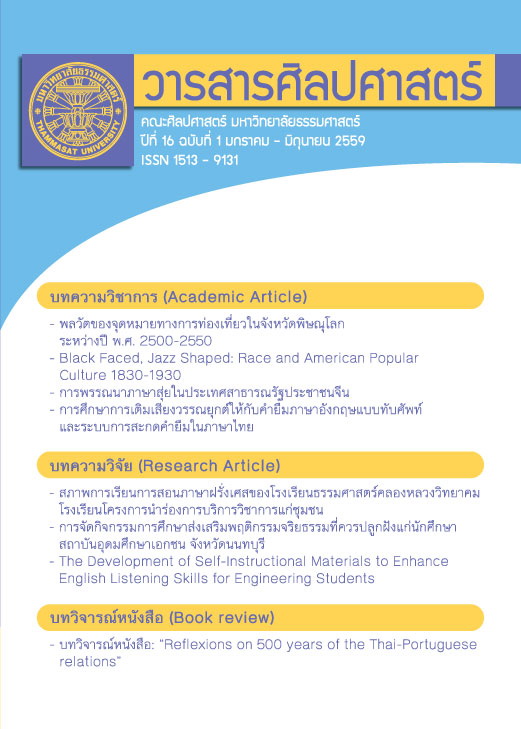The Development of Self-Instructional Materials to Enhance English Listening Skills for Engineering Students
Main Article Content
บทคัดย่อ
The main objective of this study was to develop self-instructional materials to enhance English listening skills for engineering students. The initial phase was needs analysis where questionnaires were distributed to 300 students from year 1-4 of academic year 2015 in the School of Engineering, University of Phayao in order to conceptualize materials and their academic specifications, e.g. language use and the organization of activities in each unit and physical specifications (printing and layout, the recorded sound quality of a CD). The second phase examined the results from the needs analysis along with a Six T’s approach developed using Stroller and Grabe (1997) where the contents of commercial textbooks’ and authentic materials were adapted as listening activities and learning lessons for selfinstructional materials. In the last phase, the developed self-instructional materials were tested for 8 weeks with a group of 30 engineering students from years 1-4 who failed the TOEIC mock exam. The findings indicated that after exposure through activities and lessons in the developed materials, students’ mean scores of their post listening achievement test significantly improved from their pretest score at a significance level (α) .05 and students also expressed their positive opinions towards both academic contents and physical contents of the developed self-instructional materials.
งานวิจัยนี้มีจุดประสงค์เพื่อพัฒนาสื่อการเรียนรู้ด้วนตนเอง เพื่อใช้ในการพัฒนาทักษะการฟังสำหรับนิสิตคณะวิศวกรรมศาสตร์ ในช่วงแรกของการวิจัยได้ใช้แบบสอบถามสำรวจและวิเคราะห์ความต้องการจำเป็นจากนิสิตคณะวิศวกรรมศาสตร์ตั้งแต่ชั้นปีที่ 1-4 ปีการศึกษา 2558 ของมหาวิทยาลัยพะเยา จำนวน 300 คน เพื่อใช้เป็นกรอบพัฒนาสื่อการเรียนรู้ด้วยตนเองในลักษณะของหนังสือและซีดี กรอบการพัฒนาสื่อฯ จะครอบคลุมทั้งในด้านวิชาการ เช่น ความเหมาะสมของภาษาที่นำมาใช้ในบทเรียน การจัดเรียงกิจกรรมของแต่ละหน่วยการเรียน เป็นต้น และด้านกายภาพ เช่น รูปแบบการตีพิมพ์และคุณภาพของเสียงที่บันทึกในซีดี เป็นต้น ช่วงที่สองของการวิจัยได้นำผลสำรวจความต้องการมาเป็นแนวทางในการคัดสรรเนื้อหาจากตำราเรียนเชิงพาณิชย์และสื่อการเรียนของจริงต่างๆ ที่เหมาะสม มาประยุกต์สร้างบทเรียนเพื่อพัฒนาทักษะการฟังภาษาอังกฤษตามแนวทางการสร้างสื่อการเรียนแบบ Six T ของสตรอเลอร์และเกรบ (1997) ช่วงสุดท้ายของการวิจัยได้นำสื่อการเรียนรู้ด้วยตนเองที่พัฒนาขึ้น มาทดลองใช้กับนิสิตคณะวิศวกรรรมศาสตร์ตั้งแต่ชั้นปีที 1-4 ที่ไม่ผ่านเกณฑ์การทดสอบการฟังภาษาอังกฤษจากข้อสอบ TOEIC เสมือนจริง จำนวน 30 คน เป็นเวลา 8 สัปดาห์ ผลการวิจัยพบว่าหลังการใช้สื่อฯ นิสิตมีคะแนนทดสอบสัมฤทธิ์การฟังภาษาอังกฤษโดยเฉลี่ยสูงกว่าการใช้สื่อฯ อย่างมีนัยสำคัญทางสถิติที่ระดับความเชื่อมั่น (a) .05 และยังมีความเห็นเชิงบวกต่อสื่อการเรียนฯ ที่ได้พัฒนาขึ้นทั้งด้านวิชาการและด้านภายภาพ


